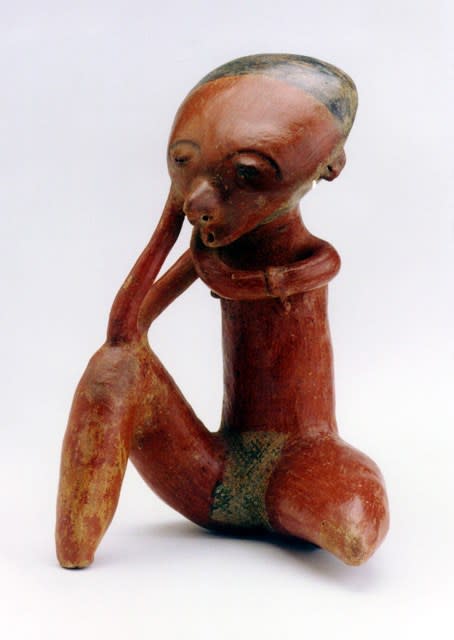Chinesco Style (Type C) Nayarit Terracotta Seated Figure, 300 BCE - 300 CE
Terracotta
10.5
PF.4515
There are many distinct groups within the agglomeration referred to as the Western Mexico Shaft Tomb (WMST) tradition, foremost among them the Jalisco, Nayarit, and Colima. Their relationships are almost...
There are many distinct groups within the agglomeration referred to as the Western Mexico Shaft Tomb (WMST) tradition, foremost among them the Jalisco, Nayarit, and Colima. Their relationships are almost totally obscure due to the lack of contextual information. However, it is the artworks that are the most informative. All of the cultures encompassed under the WMST umbrella were in the habit of burying their dead in socially-stratified burial chambers at the base of deep shafts, which were in turn often topped by buildings. Originally believed to be influenced by the Tarascan people, who were contemporaries of the Aztecs, thermoluminescence has pushed back the dates of these groups over 1000 years.
Although the apogee of this tradition was reached in the last centuries of the 1st millennium BC, it has its origins over 1000 years earlier at sites such as Huitzilapa and Teuchitlan, in the Jalisco region. Little is known of the cultures themselves, although preliminary data seems to suggest that they were sedentary agriculturists with social systems not dissimilar to chiefdoms. These cultures are especially interesting to students of Mesoamerican history as they seem to have been to a large extent outside the ebb and flow of more aggressive cultures – such as the Toltecs, Olmecs and Maya – in the same vicinity. Thus insulated from the perils of urbanization, they developed very much in isolation, and it behooves us to learn what we can from what they have left behind.
The most striking works of the Nayarit subgroup are the ceramics, which were usually placed in graves, and do not seem to have performed any practical function. It is possible that they were designed to depict the deceased – they are often very naturalistic – although it is more probable that they constituted, when in groups, a retinue of companions, protectors and servants for the hereafter. Just as in other sophisticated social systems around the world – such as the Egyptians or Dynastic China – figures were made to represent the sorts of people and resources that might be needed in the hereafter. They were in this sense symbolic of actual people, who were buried with the deceased as retainers in more sanguineous Central and Southern American societies.
Found in southwest Nayarit, this beautiful figure is said to be a "Chinesco" figure of Nayarit, a style that has become a favorite collector's choice because of their fine workmanship and exotic appearance. Though the origin and meaning are unclear, and merely a trademark, there is notably remarkable majesty of pose and serenity of expression as well as a vaguely oriental feeling. The highly polished slip further enhances the unusually delicate treatment of details such as the highbrow line, the hair, and the simple anatomical position. The pose itself is a calm and placid one. Seated with one leg raised, the figure seems poised for thought, as if predicting Rodin's famous sculpture "The Thinker". The face holds expression yet one cannot conceive of the thoughts. Though carefully and simply executed, the figure still contains an air of mystery, holding our attention as well as our curiosity.
Although the apogee of this tradition was reached in the last centuries of the 1st millennium BC, it has its origins over 1000 years earlier at sites such as Huitzilapa and Teuchitlan, in the Jalisco region. Little is known of the cultures themselves, although preliminary data seems to suggest that they were sedentary agriculturists with social systems not dissimilar to chiefdoms. These cultures are especially interesting to students of Mesoamerican history as they seem to have been to a large extent outside the ebb and flow of more aggressive cultures – such as the Toltecs, Olmecs and Maya – in the same vicinity. Thus insulated from the perils of urbanization, they developed very much in isolation, and it behooves us to learn what we can from what they have left behind.
The most striking works of the Nayarit subgroup are the ceramics, which were usually placed in graves, and do not seem to have performed any practical function. It is possible that they were designed to depict the deceased – they are often very naturalistic – although it is more probable that they constituted, when in groups, a retinue of companions, protectors and servants for the hereafter. Just as in other sophisticated social systems around the world – such as the Egyptians or Dynastic China – figures were made to represent the sorts of people and resources that might be needed in the hereafter. They were in this sense symbolic of actual people, who were buried with the deceased as retainers in more sanguineous Central and Southern American societies.
Found in southwest Nayarit, this beautiful figure is said to be a "Chinesco" figure of Nayarit, a style that has become a favorite collector's choice because of their fine workmanship and exotic appearance. Though the origin and meaning are unclear, and merely a trademark, there is notably remarkable majesty of pose and serenity of expression as well as a vaguely oriental feeling. The highly polished slip further enhances the unusually delicate treatment of details such as the highbrow line, the hair, and the simple anatomical position. The pose itself is a calm and placid one. Seated with one leg raised, the figure seems poised for thought, as if predicting Rodin's famous sculpture "The Thinker". The face holds expression yet one cannot conceive of the thoughts. Though carefully and simply executed, the figure still contains an air of mystery, holding our attention as well as our curiosity.



